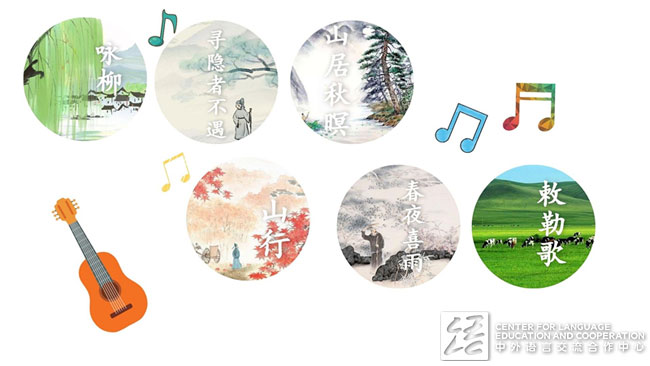Reciting the Classics, Savoring Chinese Culture^--"Reciting" to Promote the Effectiveness of Chinese Language Teaching
Information Sources:Center for Language Education and Cooperation
Chinese ancient poetry, one of the most precious treasures of China, is a reflection of the richness and depth of Chinese culture. How to teach Chinese poetry in an efficient and high-quality way so that students can deepen their understanding of the connotations of the poems and their emotional experiences through recitation, is a question worth discussing in international Chinese teaching.
In Adelaide, Australia, international Chinese language teachers have established an online poetry reciting and singing program for children, which employed the "singing" strategy to facilitate the teaching of ancient poetry by means of "learning to sing", "composing", "tuning" and so on. The process was accompanied by intriguing and entertaining themed handcraft activities and this course was highly appreciated by students and parents alike.
The online poetry course was consisted of six one-hour lessons, covering well-known ancient poems such as "The Willow", "For an Absent Recluse", "Autumn Evening in the Mountains", "Going up the Hill", "Happy Rain on a Spring Night", and "A Shepherd's Song". Firstly, before each lesson, the teacher was bound to introduce the poet and the background of the poem, and ask the students to appreciate pictures about the poem and to search for the things described in the poet, so as to guide them towards the perspective of the poet and to appreciate the natural beauty the poet wrote about and the artistic conception of the poem. Afterwards, as the students had a preliminary understanding of the poem they had learned, witty and engaging animations of the poem could help them develop a deeper understanding of it. In contrast to the abstract nature of the poems, the animations were vivid enough to convey the contents of the poems in a visual way. Lastly, the music teacher was invited to walk the students through the recitation and correct their pronunciation in time to ensure that they master the right pronunciation and rhythm of the poems.
The singing of the poems was the most desired part for students. In this session, accompanied by melodious, joyful, ardent, or soothing rhythms, the students were able to seize the pleasure of music and sing along with the rhythms, confident and absorbed. Some of them even performed solos in front of the camera for the whole class in a nice manner. The rhythmic beauty of the Chinese ancient poems flowed through the guitar of the music teacher and the students' cheerful and tender singing. Students were naturally drawn to the beauty of Chinese ancient poetry through the beautiful melodies of the music, which bridged the gap in their understanding of ancient poetry.

The handcraft session was also a big hit for the students. After learning the poem "The Willow", the students could not wait to create their own leaves paintings. A few tiny leaves were filled with their unlimited creativity, and the students celebrated the beautiful nature in their own way. With a couple of oil painting sticks and white paper, they sketched out the ethereal and nebulous beauty of the verse "I know not where, veiled by the cloud" in "For an Absent Recluse". There were also handcrafts such as paper flower baskets, rainbow rain, paper maple leaves and sheep on the grassland, which interpreted the nature and poetry in their souls.
The students could often be heard humming the melodies they had learned while they were quietly working on their handcrafts. They might not be able to recite the poems fluently in such a short time, and they might not fully understand the contents of the poems, but behind the softly humming melodies, there were the teacher’s delight of "moistening plants silently" and their expectation of "waiting for the flowers to bloom".

